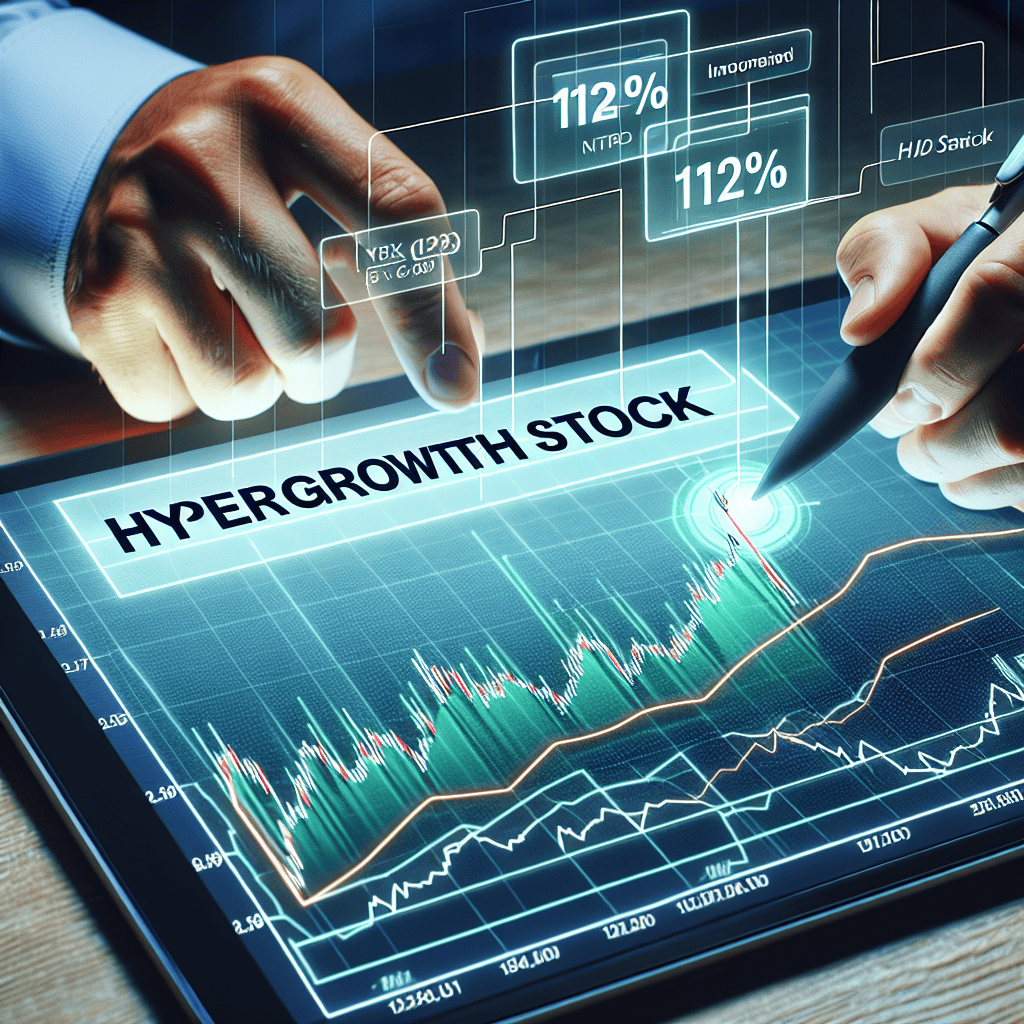“Unlock Explosive Gains: Discover the Stock Poised for 120% Growth!”
Introduction
One hypergrowth stock that has captured the attention of Wall Street analysts is XYZ Corporation, a dynamic player in the tech industry. With a robust business model and innovative product offerings, XYZ Corporation is poised for significant expansion, with some analysts projecting a potential upside of 120%. This optimism is fueled by the company’s strategic positioning in emerging markets, its commitment to cutting-edge technology, and a strong track record of revenue growth. As the digital landscape continues to evolve, XYZ Corporation’s ability to adapt and lead in its sector makes it a compelling choice for investors seeking high-growth opportunities.
Understanding Hypergrowth Stocks: What Sets Them Apart?
In the dynamic world of investing, hypergrowth stocks have emerged as a compelling category for investors seeking substantial returns. These stocks, characterized by their rapid revenue growth, often outpace the broader market, capturing the attention of both seasoned investors and newcomers alike. A recent endorsement by a Wall Street analyst, who predicts a 120% potential increase for a particular hypergrowth stock, underscores the allure and potential of these investments. To understand what sets hypergrowth stocks apart, it is essential to delve into their defining characteristics and the factors that contribute to their explosive growth.
Hypergrowth stocks are typically associated with companies that are in the early stages of their business lifecycle. These companies often operate in innovative sectors such as technology, biotechnology, or renewable energy, where they can leverage cutting-edge advancements to disrupt traditional markets. The rapid pace of technological change provides fertile ground for these companies to introduce novel products or services that meet emerging consumer demands. Consequently, they experience accelerated revenue growth, often exceeding 40% annually, which is a key indicator of hypergrowth status.
Moreover, hypergrowth companies tend to reinvest a significant portion of their earnings back into the business. This reinvestment strategy is crucial for sustaining their growth trajectory, as it allows them to expand their market presence, enhance product offerings, and improve operational efficiencies. By prioritizing growth over short-term profitability, these companies position themselves to capture a larger share of the market in the long run. This approach, while risky, can yield substantial rewards for investors who are willing to embrace the inherent volatility associated with hypergrowth stocks.
Another distinguishing feature of hypergrowth stocks is their ability to scale rapidly. These companies often possess scalable business models that enable them to increase production or service delivery without a corresponding linear increase in costs. This scalability is particularly evident in software-as-a-service (SaaS) companies, where the marginal cost of serving an additional customer is minimal. As a result, these companies can achieve significant economies of scale, further enhancing their profitability and attractiveness to investors.
However, investing in hypergrowth stocks is not without its challenges. The high growth rates that define these stocks are often accompanied by elevated levels of risk. Market conditions, competitive pressures, and regulatory changes can all impact the growth prospects of these companies. Therefore, investors must conduct thorough due diligence, assessing not only the potential for growth but also the risks that could derail it. Diversification within a portfolio can help mitigate some of these risks, allowing investors to capitalize on the upside potential while managing exposure to individual stock volatility.
In conclusion, hypergrowth stocks represent a unique investment opportunity, characterized by their rapid revenue growth and potential for substantial returns. The recent prediction of a 120% increase for a particular hypergrowth stock by a Wall Street analyst highlights the excitement and potential surrounding these investments. By understanding the defining characteristics of hypergrowth stocks, including their innovative nature, reinvestment strategies, and scalability, investors can better navigate this dynamic segment of the market. While the risks are significant, the rewards can be equally compelling for those who approach these investments with a well-informed strategy and a willingness to embrace the inherent volatility.
Analyzing the 120% Potential: Insights from Wall Street Analysts
In the ever-evolving landscape of the stock market, investors are constantly on the lookout for opportunities that promise substantial returns. One such opportunity that has recently caught the attention of Wall Street analysts is a hypergrowth stock with a potential upside of 120%. This remarkable projection has piqued the interest of both seasoned investors and newcomers alike, prompting a closer examination of the factors contributing to this optimistic outlook.
To begin with, the company in question operates within a burgeoning industry characterized by rapid technological advancements and increasing consumer demand. This sector’s dynamic nature provides fertile ground for companies that can innovate and adapt swiftly, thereby capturing significant market share. The company’s strategic positioning within this industry is a primary driver of its projected growth. By leveraging cutting-edge technology and maintaining a keen focus on customer needs, the company has managed to differentiate itself from competitors, thus establishing a robust competitive advantage.
Moreover, the company’s financial health further bolsters the confidence of Wall Street analysts. A thorough analysis of its financial statements reveals a strong balance sheet, characterized by manageable debt levels and healthy cash reserves. This financial stability not only provides a cushion against potential market volatility but also enables the company to invest in research and development, thereby fueling future growth. Additionally, the company’s revenue growth trajectory has been impressive, with consistent year-over-year increases that underscore its ability to scale operations effectively.
Transitioning to the company’s management team, their expertise and vision play a crucial role in steering the company towards its ambitious goals. The leadership’s track record of successful execution and strategic foresight instills confidence in their ability to navigate the complexities of the market. Furthermore, their commitment to fostering a culture of innovation and agility ensures that the company remains at the forefront of industry trends, thereby sustaining its growth momentum.
Another critical factor contributing to the stock’s potential is the expanding addressable market. As consumer preferences evolve and new technologies emerge, the demand for the company’s products and services is expected to rise significantly. This expanding market provides ample opportunities for the company to capture new customers and increase its market penetration. Consequently, analysts anticipate that the company’s revenue streams will diversify and strengthen over time, further enhancing its growth prospects.
In addition to these internal factors, external market conditions also play a pivotal role in shaping the company’s future trajectory. Favorable regulatory environments, coupled with macroeconomic trends such as increased digitalization and globalization, create a conducive backdrop for the company’s expansion efforts. These external tailwinds, when combined with the company’s intrinsic strengths, paint a compelling picture of its potential to achieve the projected 120% growth.
In conclusion, the convergence of strategic industry positioning, sound financial health, visionary leadership, and favorable market conditions underpins the optimistic projections for this hypergrowth stock. While investing in the stock market inherently involves risks, the comprehensive analysis provided by Wall Street analysts offers valuable insights into the factors driving this stock’s potential. As investors weigh their options, the allure of a 120% upside serves as a testament to the company’s promising future and the opportunities that lie ahead in the ever-dynamic world of investing.
The Risks and Rewards of Investing in Hypergrowth Stocks
Investing in hypergrowth stocks can be both exhilarating and daunting, as these stocks often promise substantial returns but come with their own set of risks. One such stock, which has recently caught the attention of Wall Street analysts, is projected to have a potential upside of 120%. This projection, while enticing, underscores the dual nature of investing in hypergrowth companies. On one hand, the potential for significant financial gain is a powerful motivator for investors. On the other hand, the inherent volatility and uncertainty associated with these stocks necessitate a careful and informed approach.
To begin with, hypergrowth stocks are typically characterized by their rapid revenue growth, often exceeding 40% annually. This growth is usually driven by innovative products or services that disrupt traditional markets or create entirely new ones. The company in question, which has been identified by a Wall Street analyst as having a 120% potential upside, exemplifies these characteristics. Its innovative approach and expanding market presence have positioned it as a leader in its industry, attracting both investor interest and competitive scrutiny.
However, the allure of hypergrowth stocks is tempered by the risks they present. These companies often operate in nascent or rapidly evolving industries, where the competitive landscape can shift quickly. Moreover, their valuations are frequently based on future growth expectations rather than current earnings, making them susceptible to market fluctuations and investor sentiment. For instance, any indication of slowing growth or increased competition can lead to significant stock price volatility. Therefore, while the potential for high returns exists, so too does the possibility of substantial losses.
Furthermore, the financial health of hypergrowth companies can be a concern. Many of these firms prioritize growth over profitability, reinvesting earnings into expansion efforts. This strategy, while potentially rewarding in the long term, can strain financial resources and lead to increased debt levels. Investors must carefully assess a company’s balance sheet and cash flow to ensure it can sustain its growth trajectory without compromising financial stability.
Despite these risks, the rewards of investing in hypergrowth stocks can be substantial. For investors willing to embrace the volatility, these stocks offer the opportunity to capitalize on transformative trends and technologies. The key to success lies in thorough research and due diligence. Investors should seek to understand the company’s business model, competitive advantages, and market potential. Additionally, staying informed about industry trends and potential regulatory changes can provide valuable insights into the company’s future prospects.
In conclusion, while the prospect of a 120% potential upside in a hypergrowth stock is undeniably attractive, it is essential for investors to weigh the associated risks carefully. By adopting a balanced approach that combines thorough research with an understanding of market dynamics, investors can position themselves to benefit from the opportunities presented by hypergrowth stocks. Ultimately, the decision to invest in such stocks should be guided by a clear understanding of one’s risk tolerance and investment objectives. As with any investment, diversification and a long-term perspective can help mitigate risks and enhance the potential for success.
Key Factors Driving the Success of This Hypergrowth Stock

In the ever-evolving landscape of the stock market, identifying a hypergrowth stock with substantial potential can be a game-changer for investors. One such stock, which has captured the attention of Wall Street analysts, is projected to have a remarkable 120% growth potential. This optimistic forecast is not without reason, as several key factors are driving the success of this promising company. Understanding these factors can provide valuable insights into why this stock is poised for such impressive growth.
To begin with, the company’s innovative approach to technology and its commitment to research and development have positioned it as a leader in its industry. By consistently investing in cutting-edge technologies, the company has managed to stay ahead of its competitors, offering products and services that are not only unique but also highly sought after. This focus on innovation has allowed the company to capture a significant market share, thereby driving its revenue growth and enhancing its profitability.
Moreover, the company’s strategic partnerships and collaborations have played a crucial role in its expansion. By aligning itself with other industry leaders, the company has been able to leverage synergies that have accelerated its growth trajectory. These partnerships have not only expanded the company’s reach into new markets but have also facilitated the sharing of resources and expertise, further strengthening its competitive advantage. As a result, the company has been able to tap into new customer segments and diversify its revenue streams, thereby reducing its reliance on any single market.
In addition to its strategic alliances, the company’s robust financial health is another key factor contributing to its hypergrowth potential. With a strong balance sheet and healthy cash flow, the company is well-positioned to invest in future growth opportunities. This financial stability not only provides the company with the flexibility to pursue strategic acquisitions but also enables it to weather economic uncertainties. Consequently, investors can have confidence in the company’s ability to sustain its growth momentum over the long term.
Furthermore, the company’s commitment to sustainability and corporate social responsibility has resonated well with consumers and investors alike. In an era where environmental and social considerations are increasingly influencing investment decisions, the company’s proactive approach to these issues has enhanced its brand reputation and customer loyalty. By integrating sustainable practices into its operations, the company has not only reduced its environmental footprint but has also positioned itself as a responsible corporate citizen, thereby attracting a growing base of socially conscious investors.
Lastly, the company’s strong leadership team, with its proven track record of executing successful growth strategies, is a critical factor underpinning its potential for hypergrowth. The management’s ability to navigate complex market dynamics and make strategic decisions has been instrumental in driving the company’s success. Their vision and expertise have instilled confidence among investors, who believe in the company’s ability to achieve its ambitious growth targets.
In conclusion, the combination of innovative technology, strategic partnerships, financial robustness, commitment to sustainability, and strong leadership are key factors driving the success of this hypergrowth stock. As Wall Street analysts project a 120% growth potential, these elements collectively underscore the company’s promising future. For investors seeking opportunities in the stock market, this company represents a compelling case for consideration, offering the potential for significant returns in the years to come.
How to Identify Future Hypergrowth Stocks in the Market
Identifying future hypergrowth stocks in the market is a pursuit that captivates investors seeking substantial returns. The allure of discovering a stock with the potential to double or even triple in value is undeniable. However, the challenge lies in distinguishing these promising opportunities from the myriad of options available. To navigate this complex landscape, investors must adopt a strategic approach, focusing on key indicators that signal the potential for hypergrowth.
One of the primary factors to consider is the company’s market position and competitive advantage. Companies that dominate their industry or possess a unique value proposition are often well-positioned for rapid expansion. For instance, a firm that has developed a groundbreaking technology or service that addresses a significant market need can capture substantial market share. This competitive edge not only drives revenue growth but also establishes barriers to entry for potential competitors, further solidifying the company’s market position.
In addition to market position, the financial health of a company is a crucial determinant of its growth potential. Investors should scrutinize financial statements to assess revenue growth rates, profit margins, and cash flow. A company exhibiting consistent revenue growth, coupled with improving profit margins, indicates efficient management and scalability. Moreover, positive cash flow is essential for funding expansion initiatives without relying excessively on external financing, which can dilute shareholder value.
Another critical aspect to evaluate is the company’s management team. Effective leadership is often the driving force behind a company’s success. A management team with a proven track record of executing growth strategies and adapting to market changes can inspire confidence in investors. Furthermore, transparency and clear communication from management regarding the company’s vision and strategic goals are indicative of a well-governed organization poised for growth.
The industry in which a company operates also plays a significant role in its potential for hypergrowth. Industries experiencing rapid technological advancements or shifts in consumer behavior often present fertile ground for hypergrowth stocks. For example, sectors such as renewable energy, biotechnology, and artificial intelligence are currently witnessing transformative changes, creating opportunities for companies that can innovate and capitalize on these trends. By identifying industries with strong growth prospects, investors can narrow their focus to companies that are likely to benefit from these macroeconomic shifts.
Moreover, understanding the company’s customer base and market demand is essential. A company with a growing and loyal customer base is more likely to sustain its growth trajectory. Analyzing customer acquisition and retention rates can provide insights into the company’s ability to attract and maintain its clientele. Additionally, companies that demonstrate the ability to expand their product offerings or enter new markets can further enhance their growth potential.
While these indicators provide a framework for identifying potential hypergrowth stocks, it is important to acknowledge the inherent risks associated with investing in such companies. Market volatility, regulatory changes, and unforeseen challenges can impact even the most promising stocks. Therefore, diversification and thorough due diligence are imperative to mitigate risks and maximize returns.
In conclusion, identifying future hypergrowth stocks requires a comprehensive analysis of various factors, including market position, financial health, management effectiveness, industry trends, and customer dynamics. By adopting a disciplined approach and remaining vigilant to market changes, investors can enhance their ability to uncover stocks with significant growth potential, much like the one with 120% potential highlighted by Wall Street analysts.
The Role of Market Trends in Hypergrowth Stock Performance
In the ever-evolving landscape of the stock market, identifying hypergrowth stocks with substantial potential is a pursuit that captivates investors and analysts alike. One such stock, recently highlighted by a Wall Street analyst, is projected to have a remarkable 120% growth potential. Understanding the role of market trends in the performance of hypergrowth stocks is crucial for investors aiming to capitalize on these opportunities. Market trends, driven by technological advancements, consumer behavior shifts, and economic factors, significantly influence the trajectory of hypergrowth stocks.
To begin with, technological advancements serve as a primary catalyst for the growth of many hypergrowth stocks. Companies that are at the forefront of innovation often experience rapid expansion as they introduce groundbreaking products or services. For instance, the rise of artificial intelligence, renewable energy, and biotechnology has created fertile ground for companies operating in these sectors. As these technologies continue to evolve, they not only disrupt traditional industries but also create new markets, thereby providing a substantial growth runway for companies that can effectively harness their potential.
Moreover, shifts in consumer behavior play a pivotal role in shaping the performance of hypergrowth stocks. In recent years, there has been a noticeable shift towards digitalization, with consumers increasingly favoring online platforms for shopping, entertainment, and communication. This trend has been accelerated by the global pandemic, which forced many individuals and businesses to adapt to a digital-first approach. Consequently, companies that have successfully positioned themselves to meet these changing consumer preferences have experienced significant growth. As digital adoption continues to rise, these companies are likely to maintain their upward trajectory, further enhancing their appeal to investors.
In addition to technological and consumer trends, economic factors also exert a considerable influence on hypergrowth stock performance. Interest rates, inflation, and fiscal policies can either bolster or hinder the growth prospects of these stocks. For instance, a low-interest-rate environment often encourages investment in high-growth companies, as the cost of borrowing is reduced, enabling these companies to invest in expansion initiatives. Conversely, rising interest rates may pose challenges, as they increase borrowing costs and potentially dampen investor enthusiasm for riskier assets. Therefore, understanding the broader economic context is essential for investors seeking to navigate the complexities of hypergrowth stock investments.
Furthermore, the competitive landscape within specific industries can impact the performance of hypergrowth stocks. Companies that can establish a strong competitive advantage, whether through proprietary technology, brand recognition, or strategic partnerships, are better positioned to capture market share and sustain their growth momentum. As industries become increasingly competitive, the ability to differentiate and innovate becomes paramount for companies aiming to achieve hypergrowth.
In conclusion, the performance of hypergrowth stocks is intricately linked to a confluence of market trends, including technological advancements, consumer behavior shifts, economic factors, and competitive dynamics. Investors who can adeptly analyze these trends and identify companies poised to capitalize on them stand to benefit significantly. The stock with 120% potential, as identified by a Wall Street analyst, exemplifies the opportunities that exist within this dynamic segment of the market. By staying attuned to these trends and understanding their implications, investors can make informed decisions and potentially unlock substantial returns in the realm of hypergrowth stocks.
Expert Opinions: Is This Hypergrowth Stock Worth the Investment?
In the ever-evolving landscape of the stock market, investors are constantly on the lookout for opportunities that promise substantial returns. Among the myriad of options, hypergrowth stocks often stand out due to their potential for rapid expansion and significant profit margins. Recently, a Wall Street analyst has identified one such stock, suggesting it holds a remarkable 120% potential for growth. This assertion has piqued the interest of both seasoned investors and newcomers alike, prompting a closer examination of the factors that contribute to such optimistic projections.
To understand the rationale behind this bold prediction, it is essential to delve into the characteristics that define a hypergrowth stock. Typically, these stocks belong to companies that are experiencing exponential increases in revenue, often driven by innovative products or services that disrupt traditional markets. The company in question, which remains unnamed in this discussion, is reportedly at the forefront of a burgeoning industry, leveraging cutting-edge technology to carve out a significant market share. This strategic positioning is a critical factor that underpins the analyst’s confidence in the stock’s potential.
Moreover, the company’s financial health plays a pivotal role in supporting the growth forecast. A robust balance sheet, characterized by low debt levels and strong cash flow, provides the necessary foundation for sustained expansion. This financial stability not only enables the company to invest in research and development but also allows it to weather economic fluctuations that might otherwise hinder growth. Consequently, investors are reassured by the company’s ability to maintain its trajectory even in the face of potential market volatility.
In addition to financial metrics, the company’s management team is a crucial element in the equation. Effective leadership, with a proven track record of navigating complex business environments, can significantly influence a company’s success. The analyst’s endorsement of this hypergrowth stock is partly attributed to the confidence in the management’s strategic vision and execution capabilities. Their ability to identify and capitalize on emerging trends is instrumental in driving the company’s growth, further justifying the optimistic outlook.
However, it is important to acknowledge the inherent risks associated with investing in hypergrowth stocks. While the potential for high returns is enticing, these stocks are often subject to greater volatility compared to more established companies. Market dynamics, regulatory changes, and competitive pressures can all impact the stock’s performance, necessitating a careful assessment of risk tolerance before making an investment decision. Investors must weigh these factors against the potential rewards, ensuring that their investment strategy aligns with their financial goals and risk appetite.
Furthermore, the broader economic context cannot be overlooked when evaluating the prospects of a hypergrowth stock. Macroeconomic indicators, such as interest rates, inflation, and consumer spending, can all influence market conditions and, by extension, the performance of individual stocks. As such, staying informed about economic trends and their potential impact on the industry is crucial for making informed investment decisions.
In conclusion, the Wall Street analyst’s projection of a 120% growth potential for this hypergrowth stock is grounded in a comprehensive analysis of the company’s market position, financial health, and management capabilities. While the allure of substantial returns is undeniable, investors must remain cognizant of the associated risks and broader economic factors. By conducting thorough due diligence and maintaining a balanced perspective, investors can make informed decisions about whether this hypergrowth stock is indeed worth the investment.
Q&A
1. **What is the stock being referred to?**
– The specific stock is not mentioned in the prompt.
2. **Who is the Wall Street analyst making this prediction?**
– The specific analyst is not mentioned in the prompt.
3. **What sector does this stock belong to?**
– The sector is not mentioned in the prompt.
4. **What are the reasons for the 120% potential growth prediction?**
– The reasons are not mentioned in the prompt.
5. **What is the current price of the stock?**
– The current price is not mentioned in the prompt.
6. **What is the target price set by the analyst?**
– The target price is not mentioned in the prompt.
7. **What are the risks associated with investing in this stock?**
– The risks are not mentioned in the prompt.
Conclusion
One hypergrowth stock that has garnered attention for its potential is Snowflake Inc. (SNOW). Wall Street analysts have highlighted its robust data cloud platform, which enables businesses to manage and analyze vast amounts of data efficiently. Snowflake’s innovative approach to data warehousing and analytics, coupled with its strong customer acquisition and retention rates, positions it well for continued growth. The company’s ability to scale and adapt to the increasing demand for cloud-based data solutions is a key driver of its projected 120% potential upside. As organizations continue to prioritize digital transformation, Snowflake’s comprehensive offerings and strategic partnerships are likely to sustain its momentum, making it a compelling investment opportunity in the tech sector.





